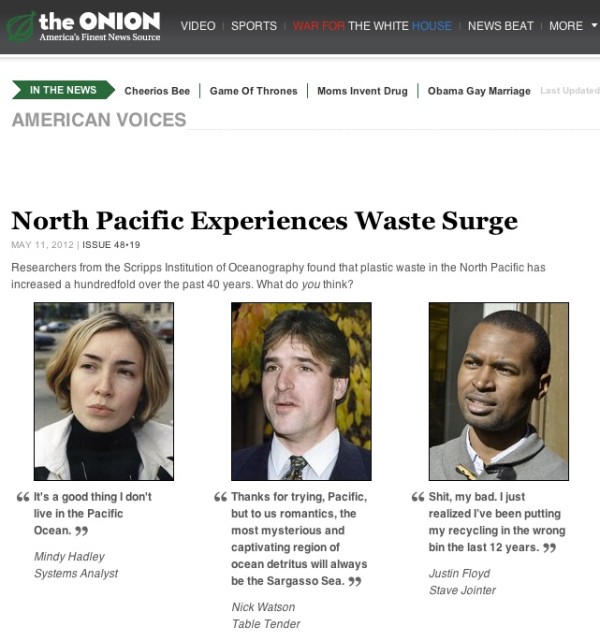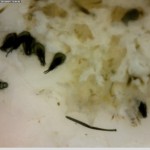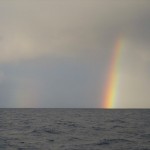You might have seen the headlines last week: Big rise in North Pacific plastic waste, Plastic in ‘Great Pacific Garbage Patch’ increases 100-fold, Ocean Trash is a Lifesaver for Insects, and so forth. These were based on a paper that I wrote with two co-authors, which came out in Biology Letters last week. Because the paper has gotten so much media attention already – including my very first Ed Yong original! – I’m not going to blog about the paper directly. Instead, I’m going to give you a glimpse behind the scenes. Since scientists-vs-media is a perennially hot topic on science blogland, I’ll explain how we prepared for and managed the media in order to achieve coverage with which we were mostly quite happy.
Having worked on North Pacific oceanic marine debris for a number of years, I knew this was going to be a hot topic. We were taken aback by the intensity of the media and public interest in our 2009 cruise to study plastic in the North Pacific Subtropical Gyre, and interest has remained steady over the past few years. So once the paper was in press, about 2-3 weeks before online publication, I gave a copy of the paper to Scripps public information officer Mario Aguilera. I’ve worked with Mario for several years now – he even came to sea with us! (that’s him on the BBC website deploying the manta net with me) – and I knew he was very familiar with the work. Mario completed the press release about a week before the paper came out, which gave me, my co-authors, and my advisor plenty of time to review it. Preparing for press coverage carefully ahead of time also gave us time to ask Anthony Smith for permission to use his wonderful sea skater photo, which you can see on the Scripps website. The paper was embargoed until Wednesday, May 9th, but media had access to it for a week beforehand. I started getting calls and emails on the Monday before it was released, which built to quite a number of inquiries by Wednesday.
My personal media policy is this: my work was paid for by United States taxpayers, California taxpayers, and private donors, and so I’ll talk to anyone who asks me polite and coherent questions, if my schedule allows. This means that I’ve done 28 interviews since last Monday – and they’re still trickling in. All these interviews probably did cost me a couple days of work – but I spent 2.5 years and a lot of money on the science on this paper! A couple of days talking to the media to tell the public what they paid for is more than fair recompense.
Our preparations and Mario’s hard work in wrangling lots of scheduling made all 28 interviews run reasonably smoothly. Also, my long-time participation in science outreach was a plus – for example, I had used Twitter to ask BBC reporter Jonathan Amos to stop by my poster at the Ocean Sciences Meeting this past February, so he was already familiar with the research before even writing the story. Doing lots of science outreach also meant that I was practiced in explaining this work to a general audience, so I wasn’t doing it for the first time when talking to a journalist. One surprising barrier was my lack of a land line – I don’t have one in my office or home. (I use a Google Voice number for my “office phone.”) I suspect this type of setup is increasingly common among younger scientists (and people in general), so I encourage the journalists out there to get familiar with Skype as a workaround. I did a couple video interviews over Skype and it worked well, though it’s probably not for novice communicators, since talking alone in your office to your laptop camera is quite challenging.
While I was pretty pleased with accuracy of the media coverage as a whole, I did run into some problems that were largely my fault. I should have realized that I needed to more carefully explain the difference between size (“Size of Texas!” which is not accurate) and concentration (100-fold increase in the number & mass of plastic PER unit seawater, which is accurate). When talking about fish eating plastic (a separate study done by Scripps students last year), I should have been more careful to mention that these fish swim up to the surface every night, and therefore may be eating plastic there, not in the depths of the ocean. That’s the stereotypical scientist trip-up – Diel Vertical Migration is an ocean phenomenon engrained in my SOUL, but it is definitely not common knowledge. Problems from the media side of things primarily stemmed from careless readings of the press release – for example, we found that sea skater EGGS were increasing, but couldn’t show statistically that sea skater ADULTS were increasing, which some reporters misunderstood.
I’m extremely grateful to Biology Letters for making our paper open access. I chose to publish in Biology Letters in part because everything is open access a year after publication, but I didn’t have the funds to make the paper open access right away. (See that pretty color figure? That’s where my money went.) I’m thrilled that Biology Letters editors saw the public interest in this topic and decided to make the paper freely available to all. I’ve made the new data from the paper open access as well – anyone can download it and take an in-depth look at Pacific plastic pollution themselves. (Thanks to the NSF-funded California Current Long Term Ecological Research site for hosting it.)
And of course, it was all worth it – because we were featured in the Onion! (“Better than Science or Nature,” according to my Twitter friends…)
I hope that this is helpful to other scientists who may be facing similar media situations. Please feel free to ask questions or share your own experiences in the comments.
[cross-posted at the SEAPLEX blog]
Share the post "Pacific plastic, sea skaters, and the media: behind the scenes of my recent paper"







Impressive job at focusing & working with media to help them tell the story. Most of what I’ve been seeing hits it and hits it surprisingly well. Great advice!
The only question I have is how the headlines got played out. Since consumer plastic use has gone up 100 times in 40 years, the notion that there’s now 100 times as much plastic in the ocean now as 1972 doesn’t seem that newsworthy. It just kind of makes sense. The -real- bit of solid, impressive, and scary news is how well the skaters have adapted to all this new floating plastic and what that means for global-scale ecological shifts. Millions of square miles of ocean ecology potentially changing because this bug gets a free ride into new places. Yet only a very few of the big papers led with that info.
My Q is, (kind of back to the “round numbers” theme in my SciAm post this week) — was that inevitable given the media’s hunger for round numbers? “100x in 40 years!” is almost impossible to resist as a lede. Or are there ways that we can keep the conversation focused on the most important bits even if they’re not the shiniest?
– Harry
Hi Harry,
Of the other three papers that I know of that have looked at the increase in plastic in the open ocean, two have found no increase, despite the rise in plastics manufacture (that’s Gilfillan et al. 2009 in the California Current and Law et al. 2010 in the North Atlantic Subtropical Gyre; Thompson et al. 2004 is the one that did find an increase in the North Sea). So while the increase that we found in the North Pacific seems intuitive, it was far from a guaranteed result. I think it’s a fair lede since no one (to my knowledge) had ever quantified this in the North Pacific Subtropical Gyre before, and that’s the area of the ocean that gets a ton of attention.
I was fully aware that if I put “100x over 40 years” in the paper & press release, it would be the lede. If I didn’t think it was important or accurate, I wouldn’t have put it in the paper or emphasized it in the press release, and the media wouldn’t have that particular shiny round number at all.
My personal strategy was to talk more about the plastic increase to non-specialist reporters, and more about sea skaters to specialist reporters (e.g., the freelancer from Science, Ed Yong). That’s because it is MUCH easier to explain the somewhat complex results to someone who is familiar with science and ecology. It’s really, really hard to explain the sea skater results to someone who doesn’t understand what a correlation is (which happened).
There’s still the apples-to-apples problem of moving gyres and changing sea states. The North Atlantic report comes from an excellent length of studies, but since (correct me if I’m wrong?) the ship never fully transected the gyre (which we know moves), it’s not honestly possible to say what the density change is. Plus, 15 years of anecdotes — and now a peer-reviewed pub — show that wind pushes buoyant plastics down in the water column. So without factoring sea state into what was found year to year, even harder for those studies to say solidly that the plastics aren’t increasing. Then of course beyond that is the VAST unknown of nonbouyant plastics (nylons, PET, vinyls, and styrenes) — as well as what happens when buoyant plastics are weighed down by biofouling.
I know that lines like “Anyone walking the beach can tell you that plastic wash-ins have increased severely in the past 20 years” have little scientific value. I try to steer clear. But again, to me “Plastics in the ocean have increased at a rate that would be predicted by the growth in use of consumer plastics” is less news-worthy. Pulled to (il)logical extreme, a great Onion headline would read “Plastics in the Ocean Have Increased Infinite Times in Past 100 Years!”
On the other hand, the headline, “Increased Ocean-Borne Plastic Greatly Expands Range of Key Marine Species” isn’t expected. It’s been hinted at, suggested maybe possible. But as scientific fact it’s a game-changer and a shocker. to me, -that’s- the smoking gun that makes people stop and say, “Hey, this is a big deal.”
I hope none of this comes off as disrespect. It’s an amazing study & a fearsome amount of work that went into it. And for all I know my angle on the thing might be the minority. It’s just — there’s this real bombshell that’s now out there, and it should be played up!
No, it’s fun that you’re taking a more critical stance. It’s what we’re SUPPOSED to do in science – in grad school you spend a couple years dissecting (and sometimes vivisecting) other people’s studies before they let you do your own. :)
Detection of a trend depends both on the magnitude of the trend, the sample size, and the variation. Plastic is quite variable, but we have a decent sample size and clearly the trend is quite strong. (We also do our best to control for wind mixing by holding season constant, albeit with a rather small sample size, in the supplementary information in our paper.) The CA Current paper only compared El Nino-neutral winter years, so that’s a reasonable control too, especially since their sample size is quite good.
But yes, to people paying attention, it’s not shocking that plastic in the ocean has increased with consumer usage. But to people who aren’t really thinking in these terms, who think there’s some special away-place where trash magically goes, I hope that seeing the increase makes them stop and think. These are people who don’t really care about the egg-laying habits of an obscure (and to be honest, not really ecologically central) little bug – but a big colored map that used to be purple & blue and now is orange & red catches their attention, and for the skeptics, there’s hard numbers to go with it.
“I spent 2.5 years and a lot of money on the science on this paper! A couple of days talking to the media to tell the public what they paid for is more than fair recompense.”
What a *wonderful* attitude. I wish more scientists would take this approach. Not every paper is going to be the subject of media interest, but getting out and talking to the public about your works seems to me to be part of the implicit contract between scientists and the taxpayers. The fact that a more scientifically literate populace can only benefit science funding is just a happy side effect.
Thanks for the blog posting and for the pro-active approach to engaging with the media.
Thanks Brad!